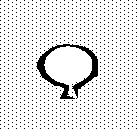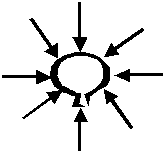Air Pressure Curriculum
Section 2—Lesson 4: Considering How Well Models Depict Air Pressure as Omnidirectional
Lesson Plan
Materials
- Inflated balloon, 1 per class
Prep Step
- Review the lesson plan, background information, and understanding goals.
Analyze Thinking
Step 1: Gathering Current Models
Present an inflated balloon to the class.
Ask: "How does air pressure work to give a balloon its shape and size? Think about this for a moment and then draw your ideas on paper."
Ask several students to share their drawings with the class. (Try to get a variety of models on the board—unidirectional models, omnidirectional models with arrows, etc.)
Note to Teacher: Presumably students will use arrows to depict air pressure in their models. Do not address this issue yet.
RECAST Thinking
Step 2: Considering What Different Models Emphasize
Put the following air pressure models on the board if they are not already represented in students' models:
 |
 |
 |
| Model A | Model B | Model C |
Note to Teacher: The models above are not relational because they do not show the air pressure inside of the balloon compared to the air pressure outside of the balloon. For now, focus on what is happening outside the balloon with the dots versus arrows models of air pressure, so that the students understand the distinction between them. Introducing students to relational causality is the focus of Section 3.
Ask: "Which model do you think does the best job showing how the balloon gets its shape?"
Discuss their ideas. Encourage students to critique each model and to consider what shape the balloon would have in each instance. Models A and B would both work (except for the lack of pressure on the inside which will come up in later lessons).
Ask: "What would happen in the case of Model C?"
Have students discuss what shape the balloon would have in Model C. If a student does bring up the lack of air pressure pushing out, underscore that there IS pressure pushing out, and this will be discussed in later lessons. An even better set of models WOULD show both inside and outside air pressure.
Explore Causality
Step 3: Considering What Causal Assumptions Are Illustrated by Each Model
Discuss the causality represented in the models with students. Ask:
- "Which model (or models) represents air pressure using unidirectional causality?" (Model C.)
- "Which model (or models) represents air pressure using omnidirectional causality?" (Models A and B.)
- "Of the two, which model do you think more accurately represents air pressure?" (The students might side with either Model A or B at this time.)
Ask students to think about the terms force and air pressure and what they mean. Have several students share their definitions with the class. If it has not already been mentioned, clarify for students the difference between force and air pressure. (A force is a push or pull on an object. Air pressure is the collective result of air particles applying forces against any object in contact with them.)
Ask:
- "Which of the two models represents force?" (Model B, with the arrows acting on the balloon in all directions.)
- "Which of the two models represents air pressure?" (Model A, with the dots.)
Discuss the difference between force and air pressure. Note how people often use the terms "force" and "pressure" interchangeably, even in models, though they represent two different things. Emphasize that air pressure is a scalar quantity. In physics, this means that it can be specified by its magnitude or size without paying any attention to direction. In other words, it's just an amount. On the other hand, force is a directional quantity. In order to describe it completely, you need to specify its magnitude and its direction.
Ask the students to recall what they learned in Lesson 3 about passive causes. Explain that air pressure is a passive cause in the sense that it exists, but doesn't actively push in any one direction. Instead, it acts in all directions. We often don't notice air pressure unless it changes. Ask,
"Do you think an arrow model or a dot model is a better depiction of the passive nature of air pressure?" (The dot model.) "Why?" (The arrows give air pressure a sense of activeness, as though it is pushing on the balloon, while the dots do not seem as active, they're just there.)
Remind students that people have difficulty reasoning about passive causes. It is very easy to fall into the pattern of reasoning about air pressure as active, and using models that make air pressure look active entices us to do so. This can lead to scientifically incorrect ideas.
Add, as a caveat to this discussion, that when air pressure changes or is unbalanced, it can cause dramatic effects in an active sense. They will have the opportunity to learn about this in later lessons. But when air pressure is balanced, its effects typically go unnoticed.
Review, Extend, Apply
Step 4: Revisiting Students' Earlier Models
Have students return to their own models of the inflated balloon that they drew at the beginning of the class. Ask: "Was air pressure well-represented in your model? If not, revise your model."
Suggest that students use dots to represent air pressure for the remainder of the unit.


